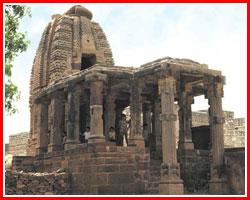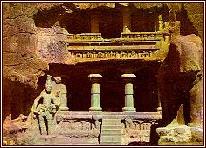Early Medieval India (650-1206 AD)
In the post Harsha period, three great centres of powers emerged in North India and Deccan: Gurjara-Pratiharas, Palas and Rashtrakutas.
Gurjara-Pratiharas The Gurjara-Pratiharas were the early Rajputs who began theri rule from Gujarat and south western Rajasthan. Later they ruled from Kanauj. Nagabhata I was the first great ruler of the dynasty. He defeated the Muslim forces of Arab. Bhoja I (AD 836-885) was the most famous ruler of this dynasty. He was a devotee of Vishnu and adopted the title of Adivaraha, which has been incorporated as a legend on some of his coins.
 Palas The Pala dynasty came into power in Bengal in about the middle of the eighth century AD. The founder of this dynasty was Gopala I who was elected as the king by the people. Dharampala and Devapala were the most famous rulers of this dynasty. They extended and consolidated the Pala empire. The Palas ruled over Bihar, Bengal and part of Orissa and Assam with mny ups and down in their learning and religions. Dharmapala founded the famous Buddhist monastery at Vikramshila, which became second only to Nalanda in fame as a centre for higher learning. During Devapals's reign, the king of Suvarnadvipa(South East Asia), Balaputradeva, built a monastery in Nalanda and requested Devapala to endow the income of five villages for the maintenance of the monastery.
Palas The Pala dynasty came into power in Bengal in about the middle of the eighth century AD. The founder of this dynasty was Gopala I who was elected as the king by the people. Dharampala and Devapala were the most famous rulers of this dynasty. They extended and consolidated the Pala empire. The Palas ruled over Bihar, Bengal and part of Orissa and Assam with mny ups and down in their learning and religions. Dharmapala founded the famous Buddhist monastery at Vikramshila, which became second only to Nalanda in fame as a centre for higher learning. During Devapals's reign, the king of Suvarnadvipa(South East Asia), Balaputradeva, built a monastery in Nalanda and requested Devapala to endow the income of five villages for the maintenance of the monastery.
 Rashtrakutas The Rashtrakutas called themselves descendants of Satyaki. The founder of the Rashtrakuta power was Dantivarma or Dantidurga who was a contemporary of Chalukya King Pulakeshin II. Dantidurga occupied all territories between the Godavari and the Vima.
Rashtrakutas The Rashtrakutas called themselves descendants of Satyaki. The founder of the Rashtrakuta power was Dantivarma or Dantidurga who was a contemporary of Chalukya King Pulakeshin II. Dantidurga occupied all territories between the Godavari and the Vima.
Dantidurga was succeeded by his uncle Krishnaraja (768-772). Krishnaraja was responsible for the construction of the Kailash Temple of Ellora which stands as an excellent specimen of the Rastrakuta art and architecture.
Points to Remember
|
The Rashtrakutas kept on the best of terms with the Arabs of Sindh and enriched their subjects by encouraging commerce
They encouraged Hinduism and Digambara Jainism
Their capital was at Manyakheta
The king Amonghavarsha I himself authored a part of Kavirajamarga, the earliest known Kannada poem.
Rashtrakutas were the followers of Jainism.
|
The greatest king of the Rashtrakuta dynasty was Amoghavarsha. Asa warrior, he was, however no match with his father Govinda II, but he succeeded in defeating the East-Chalukya kings. It was Amoghavarsha who had successfully arrested the progress of the Gurjara King Bhoja I towards South India.
|
Temples Constructed by Rashtrakutas
|
Temples
|
Place
|
Constructed By
|
Vijalaycholeshwar
|
Naratmatai
|
Vijayalaya
|
Balsubramaniyam
|
Kannanur
|
Aditaya I
|
Nageshwar
|
Kuminakanam
|
Aditaya I
|
Kornagnain
|
Sriniwasnallur
|
Vartak I
|
Moverkaite
|
Padukottai
|
Bhutivikram Kesiri
|
Tiruvaleswaram
|
Brahmadesha
|
Raj Raj I
|
Uttarkailash
|
Tiruvadi
|
Raj Raj I
|
Rajrajeshwar
|
Tanjore
|
Rajendra I
|
Gangaikondchola
|
Gangai Kondacholapuram
|
Rajendra I
|
Airavateshwar
|
Darsunam
|
Raj Raj II
|
Kamhaveshwar
|
Tirumaranam
|
Kallotunga III
|
Tripartite Struggle The most important event of post-Harsha Period was tripartite struggle among the Gurjara-Pratiharas, Rashtrakutus and Palas for the supremacy of the north. This struggle started during the reign of Vatsaraja-Pratihara. He ascended the throne in 778 AD. In order to give practicle shape to his imperialist designs, Vatsaraja attacked Dharmpala, the Pala King of Bengal, and carried away his state umbrella. The majore causes for the continuous struggle between the Pratiharas, Palas and Rashtrakuta, known in history as tripartite struggle, are as follows:-
To get control over Gujarat and Malwa, the regions very important for foreign trade due to their nearness to the coast.
To acquire supremacy over kanauj, a symbol of prestige in Indian politics.
To get control over the vast resources of the Gangetic valley.
Desire to impress the pretty kingdoms with the sense of their might.
Lust for war booty, a prominent source for maintaining huge army
Kashmir Kashmir was ruled by three dynasties- the Karkota, Utpala and Loharas. Lalitaditya was the most famous ruler of Kashmir during this period.
